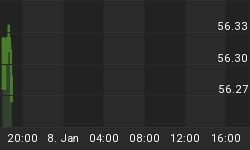It is on days like this that I realize just how little most of the investing world cares about fixed-income. To be sure, the big investors and the smart ones (despite popular opinion, there is some overlap between these sets, but perhaps not as much as we might like) care about bonds, and of course they should - and especially inflation-indexed bonds, since the investor's fundamental goal is to maximize real after-tax wealth over time subject to risk appetite. But people still think stocks are the sexy asset. Evidence: CNBC barely bothered to broadcast today; it carried the Employment number and then turned away from news and toward "interest programming."
Probably, no one will read this comment. My Friday comments never get read as much as comments the rest of the week, which is one reason I often delay publishing them until Sunday. In this case, however, I will be on vacation in the Cayman Islands come Sunday, and for the next week, so whether anyone reads it or not, here it comes:
The Employment data was not too far from expectations, especially when revisions are included (quite far from Deutsche Bank's expectations, but not from most economists'). The Payrolls figure of 162,000 new jobs was pretty close to the ~180k consensus, and there were upward revisions to prior months. Now, while the headlines all weekend will trumped the strongest jobs growth in years, a fair reading of the numbers would temper enthusiasm somewhat. First, part of the jobs growth in the last two months has obviously been due to the hiring of Census workers, a temporary chore. In February and March combined, the Census Bureau added 63,000 workers. Moreover, it isn't really fair to look at just March, which contained the weather snap-back, without considering February's weather-dampened data. Averaging the two, net of Census workers, gives us a whopping 42k new jobs per month of underlying jobs growth. Certainly, that's better than we had last year, but nothing to write home about - it's still quite a bit less than the number needed to keep the Unemployment Rate stable over time. Indeed, the Unemployment Rate just missed an uptick, moving to 9.749%.
Internals to the data confirm the overall sense: this represents a modest, but very modest, improvement over recent trends. There is certainly nothing there that suggests the recovery is suddenly igniting in the way recoveries tend to. Normal recoveries, that is.
The bond market traded down on the number, fairly aggressively. What I read into that, despite the thin conditions, is that the bears are in control: no one seemed to want to dig into this at all to see if there was much to it (and there isn't anything very exciting or surprisingly-strong, at least, to trigger such a move).
I am in the same camp. While I think the feeling that seems to be growing again that there are "green shoots" in this economy - maybe that happens every spring - are going to turn out to be disappointed, I am not bullish on bonds. As I have written here recently, I am bearish in the near-term as I think we'll go through 4% on 10 year yields fairly easily now. The market closed with the 10y at 3.95%, so that's not a big call - we may have gotten there today if the market hadn't been scheduled to close at 11:00 ET! There are other support levels nearby, including a very big one that I think stands a decent chance of giving way. I have been using the chart below for years to argue that the secular bull market was still in place. Plotted are 10-year Treasury yields, monthly close, on a logarithmic scale (such long-term and large-scale moves usually need to be on log scale. The upper end of that channel? Right now, the line is at 4.14%.

The Big Test Comes Soon
As I said, there are some near-term support levels for the market, including 4% and that 4.14%. But we are also in a period that is very challenging for market bulls anyway. In 18 of the last 29 years, 10-year yields have risen in the 30 days following April 2nd, by an average of 14bps (the average includes the rallies as well as the selloffs. The average move, conditional on the fact that there was a selloff that year, was 32bps). See Chart below.

Tailwind To The Bearish Case
What is the driver, if it isn't that there really are "green shoots"? Well, additional Treasury supply doesn't hurt. But, while the recent plunge in the growth rate of money and credit numbers (see Chart below, source Bloomberg) may be good for inflation expectations in the long run...with a whole lot of caveats to that, by the way, which will make for a column another day...they are not very supportive of asset markets. Money's gotta come from somewhere to buy assets.

If Assets Are Going Up, Where Will The Money Come From?
As noted above, I am out next week on vacation, and I will not be posting commentaries from the beach. I'll return with something fresh to say. Maybe.
















